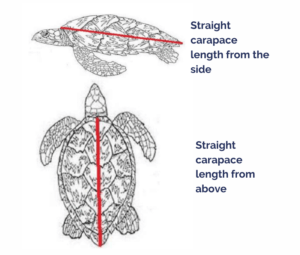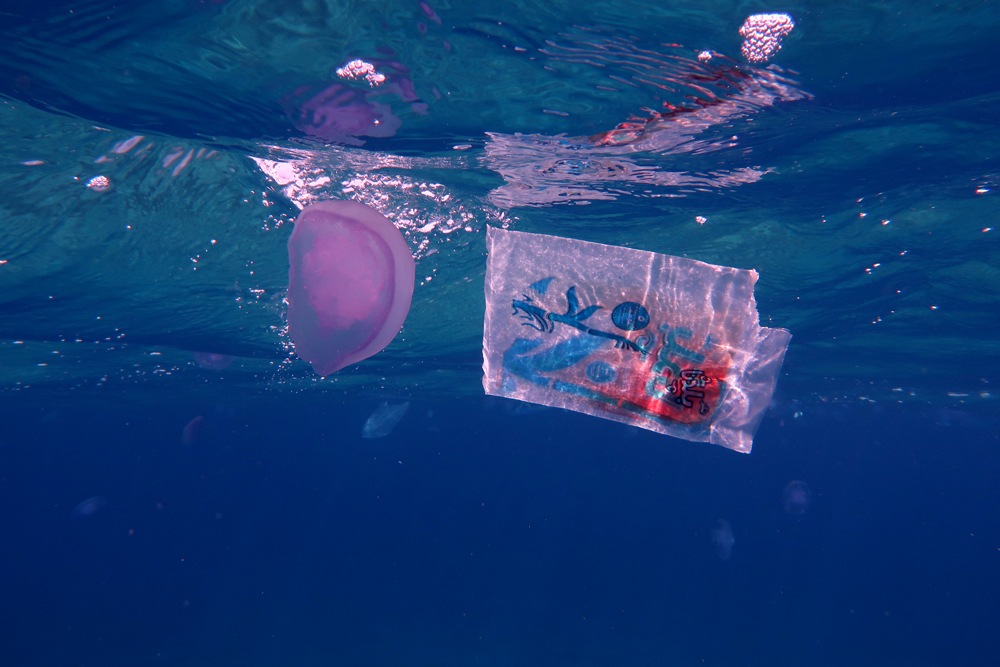It is possible to understand whether a turtle is juvenile or adult based on its straight carapace length (SCL). What is it? The SCL is the length of the carapace only, from the neck to the tail of the turtle without considering the curvature of the carapace. If you can provide the estimate of the turtle’s straight carapace length, we could be able to tell if you have seen a young or adult individual. As we need to keep a minimum distance of 2m from a turtle, the best way to estimate the carapace length is by comparing it to the length of something else (i.e. another diver, a section of the reef, etc).
DID YOU KNOW?
Sex can be identified only in adult or sub-adult individuals (carapace length of more than 70cm). The best way to identify the sex of a turtle is by observing its tail. If the tail extends well beyond the carapace (>20cm), it is an adult male. The tail of a female turtle is short and usually extends only slightly beyond the end of the carapace (< 10cm).
Illustrations: “Pictures modified from Research and Management Techniques for the Conservation of Sea Turtles (IUCN-SSC, 1999)”
Marine turtles have a very well developed sense of smell. It is believed that their strong sense of smell as well as vision, helps marine turtles locate their source of food; being able to find food through smelling becomes especially useful when sight cannot help much – such as in dark or turbid waters!
Unfortunately, there are some situations in which their powerful sense of smell leads them in the wrong direction: when plastics stay in the ocean water for a while, they smell (and look) like food (e.g. jellyfish!) to turtles – that is why sometimes marine turtles appear to be attracted by plastic bags floating in the ocean!
Curiosity: it is possible that sense of smell is somehow involved in helping female turtles return to their home beach to nest!
Source: Wyneken, J., Lohmann, K. J., & Musick, J. A. (2013). The biology of sea turtles. Volume III. CRC Press. https://doi.org/10.1201/b13895
Yes! As they are reptiles, marine turtles are “ectotherms”, this means that their body temperature depends on sources of heat that come from the external surroundings, so their own temperature varies according to how cold or hot their environment is.
For humans it is different: we are “endotherms” and our metabolism is generating the heat we need to warm our tissues.
Marine turtles though have developed fascinating adaptations in order to maintain the vital organs in function, even in “difficult times”: they have a circulatory system that keeps the core of the body warmer than their extremities and in case of distress, they can dilate or constrict blood vessels in order to control the heat dispersal!
Source: Wyneken, J., Lohmann, K. J., & Musick, J. A. (2013). The biology of sea turtles. Volume III. CRC Press. https://doi.org/10.1201/b13895
It could happen to see a marine turtle “crying” while nesting. Is it because she feels pain? The answer is: no, she is simply expelling the excess of salt in her body fluids!
As marine turtles live in a salty environment they, like many other marine reptiles and marine birds, have a special system to expel the excess of salt (coming from food and from drinking seawater): they have SALT GLANDS that are located behind the eyes!
The liquid secreted reminds us of tears, that is why someone could think that the turtle is “crying”!
Curiosity: leatherback sea turtles have very large salt glands…why? Because they LOVE eating jellyfish and since jellyfish are composed mostly of seawater, leatherback turtles ingest a high quantity of salt while feeding they need to expel a lot of salt!
Source: Wyneken, J., Lohmann, K. J., & Musick, J. A. (2013). The biology of sea turtles. Volume III. CRC Press. https://doi.org/10.1201/b13895
Sea turtle ears: we can not see them from the outside! They are fairly small and they are covered by thick skin (a ring of scales similar but smaller than those on the rest of the head: sea turtles need to keep water out while allowing vibrations in) and a fatty layer, which is typical of sea turtles! Due to those layers, the turtle will hardly hear well in air, but thanks to them, underwater sounds will be able to reach the inner ear.
Curiosity: apparently sea turtles are more sensitive to low-frequency sounds.
Source: Wyneken, J., Lohmann, K. J., & Musick, J. A. (2013). The biology of sea turtles. Volume III. CRC Press. https://doi.org/10.1201/b13895
We, as humans, have eyes with rather flat lenses and a curved cornea, which is what refracts light and helps us see well in the air, while under the water, corneas are ineffective and that is why we have an underwater blurred vision.
Fish have a cornea merely as a protective barrier and a more spherical lens, which is what they use to refract light and be able to see underwater.
How about sea turtles? They spend most of their time underwater, but they still need “land” to breathe, to nest (females sea turtles), and during the very first phase of their lives, when they hatch! Their eyes are better adapted to the underwater world, in fact, they have flat corneas and a nearly spherical lens, but they are also able to see in the air (although they are slightly nearsighted on land).
Curiosity: Sea turtles apparently can see better in bright light conditions than in dim water!
Source: Wyneken, J., Lohmann, K. J., & Musick, J. A. (2013). The biology of sea turtles. Volume III. CRC Press. https://doi.org/10.1201/b13895









